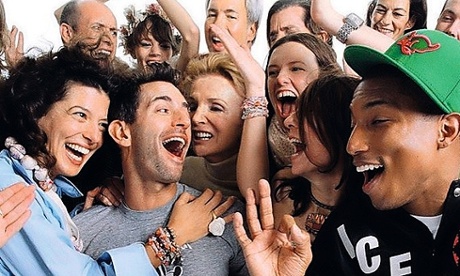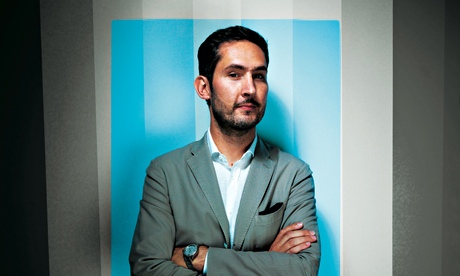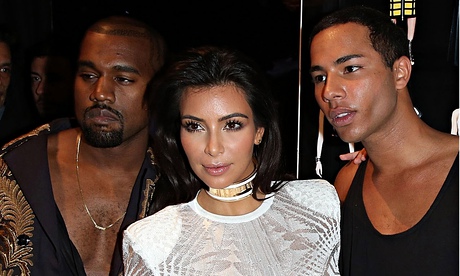You know that navy blazer, the really expensive one that you bought because fashion editors like me told you it was a for ever classic, that trends were over? Well, it’s no use this season. Sorry about that. That new age of minimalism that we confidently heralded – the end of the trend circus, a clean slate of perfect white shirts – well, it didn’t last. The new season is about eclecticism and eccentricism, colour and clash. Even Phoebe Philo, whose Céline catwalk shows pushed fashion as close as it may ever get to asceticism a few years ago, embraced print, detailing, quirky humour in her Paris fashion week show earlier this year.
But never mind Paris fashion week. That’s not where trends happen any more. It’s not London, either, or New York, or Milan. Because the catwalk is no longer at the heart of fashion – Instagram is. Just as Twitter has become central to political life, as a filter that quickly and organically separates those issues that grab people’s attention from those that don’t, Instagram sets the fashion agenda.
A trend can be all over the catwalk but if it doesn’t make it into our Instagram feed, it is dead in the water. The borderline-ugly clompy loafers that were a fashion week look a few months ago might never have caught on if it hadn’t been for a trickle of celebrity Instagrams. In June, the actor and model Suki Waterhouse – whose feed features mostly party frocks and swimwear – instagrammed a photo of her pointy, tasselled Coach loafers. Soon after, Lupita Nyong’o posted a snap of herself outside a Paris cafe, wearing Birkenstock-style shoes with an elegant white dress. The borderline ugly shoe was in. No single person can make or break a look on Instagram, and it is this sense of democracy that gives it authority; but a clutch of high-profile types can make something happen.
What’s more, because Instagram has its own visual language – a kick-your-shoes-off, make-a-silly-face mode, quite different from the pop-a-hip and suck-in-the-cheekbones look seen on catwalks and the red carpet – trends become more accessible. Off-the-shoulder blouses looked austere and impractical at the shows; when they began to crop up on the feeds of fashion influencers such as the blogger Leandra Medine, aka Man Repeller, wearing one suddenly felt possible.
“In the morning, it used to be, ‘Did you see such-and-such on TV last night? Did you see what she was wearing?’” says Sheena Sauvaire, global marketing and communications director at Topshop. “Now it’s always, ‘Did you see so-and-so’s Instagram?’” This season’s flip from minimalism to maximalism is not just about the pendulum swing of fashion. Sarah Watson, vice-president of social commerce at Net-a-Porter, calls social media “a global fashion mood board that everyone can contribute to”.
Fashion has become more inclusive, but in this new visual free-for-all, a look has to shout to be heard. “In order to get any kind of cut-through, what you offer needs to be loud and proud,” says Sauvaire. It is a level playing field, but a crowded one; and so in the new pecking order the peacock is king. The fabulously-dressed show-off of autumn/winter 2015 is a different creature from the hard-nosed, designer-clad fashion mean-girl of old, who would have sold her grandmother for a front row seat. Social media has rewritten the rules of engagement in all areas of life, ushering in an era when being personable and connected is the new awesome. Nowhere is the change starker than in fashion, which, having had a tendency to take itself seriously, has become friendlier and more lighthearted. “There was a time when, if you met someone interesting in a meeting, you would swap business cards,” says Sauvaire. “Now it’s all about whether you start following each other online.”
Those Oxford Street shop windows, with groups of four or five girls, arms around each other? That is a meme that began on Instagram (#squad), and that younger brands have begun to echo in their marketing. The goofy smiles and dorky hand gestures that you see in ads these days? You can trace a direct line of descent from Cara Delevingne’s posts. A new generation of models has embraced this power shift: it used to be the case that once models became powerful enough, they would break rank and refuse to be photographed in groups, but Kendall Jenner, Gigi Hadid and the class of 2015 – the Instagirls – know full well that, like a girl band, their togetherness is more than the sum of their parts.
Smiling is the new pouting, friendly the new cool and softly-softly the new hard sell. “Instead of the lofty coolness of the past, social media favours likability and being – or appearing to be – genuine,” says Siobhan Mallen, content director of Amazon’s new fashion arm. Brands talk about inviting you to look into their “world”, and refer to models and spokespeople as their “family”. At Burberry, designer Christopher Bailey was one of the first to wake up to the commercial potential of social media. “Platforms like Instagram and Snapchat are so visual, so democratic and so full of creative possibility,” he says. “Most of all, however, they allow you to develop your personality as a brand.”
The internet has made superstars out of a lucky few bloggers and street-style stars. Chiara Ferragni, aka the Blonde Salad, started with a blog and now has a fashion empire that includes a brand with a show at Milan fashion week (her success was the subject of a recent case study by Harvard Business School). The power of the supermodel has been amplified. Al MacCuish, of creative agency Sunshine, points out that Delevingne and Jenner have a combined Instagram following of 56 million, far more than any of the fashion brands or magazines that employ them.
In the noughties, after internet startups came along and shook up the business world, it was noticeable that even old-school companies began to ape their appearance and behaviour. Ping pong tables, brightly coloured sofas and designer coffee machines began to appear in the offices of traditional companies. In the same way, the lo-fi, casual tone that Instagram represents – in contrast to the hushed, library-seriousness of traditional fashion photography – is being mimicked across the industry. The mirror-selfie is the ultimate Instagram motif, because anyone can take one. Kim Kardashian and Victoria Beckham are both partial to a mirror-selfie, because they know their audience will relate to them.
In advertising, brands now try to replicate the natural feel of social media. “When this is done well, it’s difficult to distinguish between user-generated and commercial content,” says Simon Glover of creative agency ODD. “This could be photos of outfits arranged obsessively on a flat surface, or a top-down shoe shot.” Natalie Kingham, buying director at matchesfashion.com, points to the current Valentino campaign, with its graphic backdrop and street-style braids, as evidence of Instagram’s aesthetic influence. At Topshop, says Sauvaire, “campaigns used to be all about the iconic double-page spread. Now we’re thinking about the Instagram format when we’re shooting, and the 15-second video clip.”
This influence filters down on to the street. “Often it’s the styling details,” says Sauvaire. “The T-shirt tied to one side, worn with denim – that was on Instagram over Coachella, and then it was everywhere.” This summer has seen a scattering of recognisable Instagram-inspired trends: white dungarees and brightly coloured bomber jackets, for instance. Last summer, it was mesh T-shirts over contrasting coloured sports vests.
It’s funny to think, now, that until very recently much of the fashion industry didn’t really get the internet. In February – this February – Marc Jacobs told Vogue that he was “so appalled by the whole social media thing… It doesn’t appeal to me; neither does a computer, or working on a laptop.” In March, he joined Instagram. The about-turn seems likely to have been motivated by hard-nosed business sense, but (apart from one apparently accidental posting, and not-quite-soon-enough deletion, of an, ahem, intimate selfie) Jacobs has taken to the platform like a duck to water, posting videos of late-night lols with Kate Moss and other pals, to the delight of his now 3.1m followers.
These days, catwalk shows are planned with social media in mind. In March last year, the Chanel show was staged in a fake hypermarché fully stocked with Chanel-branded goods such as Coco Pops (geddit?) and Jambon Cambon ham, named after the Rue Cambon headquarters of the brand. The vibrant colours, the hi-lo taste mash-up, the endless artillery for punning captions made for a show that flooded Instagram even before the first outfit appeared, and dominated the fashion airwaves for days. In February this year, Kanye West’s show for Adidas at New York fashion week was choreographed to take place in a perfect, Insta-friendly square. Coincidence? Bear in mind that Kanye spent four days of his honeymoon retouching and filtering the wedding photo that became the most-liked photo on Instagram, a record it held for a year – until it was broken by Kanye’s model sister-in-law Kendall Jenner, posting a picture of her hair arranged in love hearts.
In June, Instagram announced the inevitable: the introduction of a ‘“Shop now” button, which will appear in the bottom right-hand corner of advertising posts. Retailers are predictably enthusiastic, but the direct-marketing tone may prove too jarring in a feed that for many users includes photographs of family and friends. Key fashion players have been working on ways to monetise all this online enthusiasm without killing the mood. Burberry has made careful alliances with platforms including Twitter and Snapchat, where the most recent catwalk show was shown before it appeared on the catwalk, as well as Instagram. “We will have more of these in the future as the commercial and creative elements of social media continue to blend,” Bailey says.
In May, Net-a-Porter launched the Net Set app, which Natalie Massanet described as “to mobile in 2015 what net-a-porter.com was to a desktop in 2000”. The shoppable app mimics the warm tone of Instagram (clothes are added to a wishlist by clicking on a familiar-looking chubby heart motif) and annexes the influence of social media stars such as model Laura Bailey and Julia Restoin Roitfeld on its Style Council. Alexa Chung’s new venture Villoid is a shoppable app that aims to capture the fun of shopping and dressing up with your friends. Pointing to the scene in cult 90s film Clueless where Alicia Silverstone uses a computer programme to pick an outfit as an influence, Chung brings her signature goofy humour to the technology. Social media has changed how we want to dress – and now, it’s going to sell you your new wardrobe. Smart.
Six instagrams to follow
@susiebubble Most Instagram fashion plates look the same, but Brit blogger Susanna Lau’s outfits are a unique, colourful joy.
@derekblasberg Best friends with supermodels and a winning way with a pun. Major FOMO warning.
@chiaraferragni Also known as the Blonde Salad; a blogger and Instagram institution with more followers than Calvin Klein, for whom she is a brand ambassador.
@franburns Stylist and contributing fashion editor to Vogue, Fran Burns posts a glorious stream of classic fashion photography and references.
@evachen212 Magazine editor turned Instagram insider; the Anna Wintour of social media, with lots of Manhattan shots.
@guardianfashion The coolest, classiest behind-the-scenes look at the fashion industry – and funny, too, naturally.











